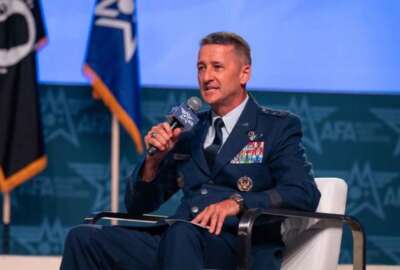U.S. Cyber Command is aiming to expand its acquisition team and rely on flexible buying strategies as CYBERCOM becomes a focal point of cyber procurement in the Defense Department.
The command was initially granted limited acquisition authority in fiscal 2016, with 10 billets and $75 million in buying authority over five years. Congress has since lifted the command’s spending limitations and restrictions.
Courtney Maggiulli, the program executive officer for cyber, J9 acquisition and technology at CYBERCOM, said her PEO is aiming to add 50 billets this year.
“So we are staffing up for a right sized and ready workforce, and it’s a pretty exciting place,” Maggiulli said at the CYBERCOM legal conference last week.
Earlier this year, the command was also designated as a federal laboratory. The designation gives CYBERCOM more authorities to work with industry and academia on technology research. Additionally, it also has “enhanced budgetary control,” meaning it has a greater say in how DoD makes decisions about cyber programs and investments.
“So we’re expanding our ability to acquire cyber goods, cyber services for the DoD in an integrated and holistic way,” Maggiulli said.
And CYBERCOM is also building out a program office to oversee and integrate the “Joint Cyber Warfighting Architecture,” a collective term for the cyber products and services used across the military services by the 133-team Cyber Mission Force.
“Integration is crucial, because things are changing every day,” Maggiulli said. “And we have to be unified. We bring together the best in breed of all the different tool capabilities. And most importantly, it’s the talent of the people across the services as well.”
But as it builds out its acquisition program, Maggiulli said CYBERCOM is acutely aware it can’t rely on the traditional DoD acquisition system to buy and integrate new cyber capabilities.
“The cyber domain is different,” she said. “It’s fast, it’s rapid. So we don’t have the ability to take the time that you would normally put into building a tank or a fighter jet or putting up a satellite in 10 years. We don’t have 10 years to wait.”
She pointed to the command’s early collaboration with the Defense Innovation Unit to procure “Hunt Forward” cyber mission kits using DIU’s prototyping process. DIU typically uses Other Transaction Agreements that aren’t governed by the Federal Acquisition Regulation.
“We are committed through what our lab is doing and through our teams of professionals and then through our partnerships with folks like DIU to growing that innovation at the command,” Maggiulli said.
CYBERCOM is also leaning on DoD’s Adaptive Acquisition Framework to tailor its procurement strategies for the cyber domain.
Maggiulli referenced both the software acquisition pathway and the middle tier of acquisition pathway as “allowable ways to pursue acquisition that have strategies that are more responsive and tailored to the types of acquisitions we’re doing.” The software pathway uses agile development and DevSecOps practices, while the middle-tier authority is used to quickly prototype and field new capabilities.
“We’re being given flexibilities and tools by Congress that allow us to be faster and more responsive for the type of acquisition we’re doing with cyber,” Maggiulli said.
A key aspect of CYBERCOM’s acquisition ambitions will be training and empowering its growing acquisition workforce, she added. The command is using training programs through Defense Acquisition University to build an education and culture around what Maggiulli hopes is a creative acquisition program.
“It’s not a stodgy and antiquated and outdated acquisition model that we want people to come in with,” she said. “We really want to leverage these tools that we’ve been given with a workforce that knows how to use them strategically and effectively.”
Copyright
© 2024 Federal News Network. All rights reserved. This website is not intended for users located within the European Economic Area.





